Investigation
Greetings kind traveler, and welcome to this week’s From the Workshop. This is Mystery Week, and as your players lose track of your major villain and nobody can explain how the mayor’s daughter went missing, this article will do what it can to help aspiring investigators in their task to solve the case. Today we will examine a number of skills one by one, exploring their possible uses for the purposes of investigation.
There are three forms of investigation. A field investigation takes the investigator on the scene of an event, whether criminal or not, searching for clues on the environment itself. An information investigation requires searching on theoretical sources to better understand the situation, whether this involves browsing libraries or asking those in the know. Finally, a social investigation requires asking the right questions to those involved in the scene, whether victims, witnesses or suspects. The following paragraphs examine these three forms in extensive detail.
All rolls related to investigating an incident do not typically permit a reroll. Instead, a reroll is possible if a new lead is uncovered connected with the information sought. In any case, when a roll is made to confirm justified suspicion rather than to find a new lead, the relative DC is decreased by 2. An investigator’s kit, costing 20gp, provides a +2 bonus to all rolls related to the examination of an item or a body. Rolls related to investigation should be made in secret.
The Scene of the Crime: Three dead bodies in the middle of a shrine of Jesbel. What happened here? Two of the bodies bear numerous wounds, while the third, a female priest, displays a single injury on the chest. The only weapon on the scene is a morningstar, covered in blood, lying on the floor. Recognizing the morningstar as a symbol of the shrine’s deity, the local authorities are quite eager to put the blame on an internal conflict of Jesbel’s clergy. Chaska Boulevard, a renowned investigator, sits silently among shouting guardsmen and crying family members, trying to concentrate on the facts.
Appraise: Slowly lifting the morningstar from the ground, Chaska examines the item. Something is wrong here. The weapon is bronze, bearing delicate patterns. Certainly this one belongs to the clergy. But all the spikes are still lustrous and uniform. Also, the entire head of the weapon is covered in blood. No, this is not the weapon of the murder. In fact, this weapon was never bashed violently. Instead, it was dipped in blood either before or after the incident. A framing attempt? The Appraise skill can be used to obtain information from a held item. The examination takes at least 1 minute. The following table presents various leads that could be gained through Appraise, along with their relative DCs:
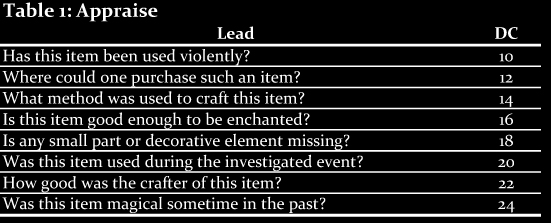
Heal: It doesn't take a genius to understand that the wounds displayed by the two men are not related to the morningstar, let alone the injury of the female priest. But the question still remains: how did they die? Chaska, kneeling in front of the first body, softly touches the brutalized skin. It seems like it was cut with a long blade. But there is something more. The skin is far too mutilated for the weapon to be a plain, smooth blade. It's a serrated blade! The second male body has remarkably similar wounds. But the female one is considerably different. A single hit. In the chest. The investigator was almost ready to conclude that this was made with a rapier, or a similar piercing weapon, but then realized another detail. Whatever pierced the chest of this woman, never came out! The investigator is far from familiar with magic, but she is almost certain that the weapon that caused the wound disappeared soon after. Much like the Appraise skill, the Heal skill can be used to obtain information from a dead body after at least 1 minute of examination. The following table works as the previous one:
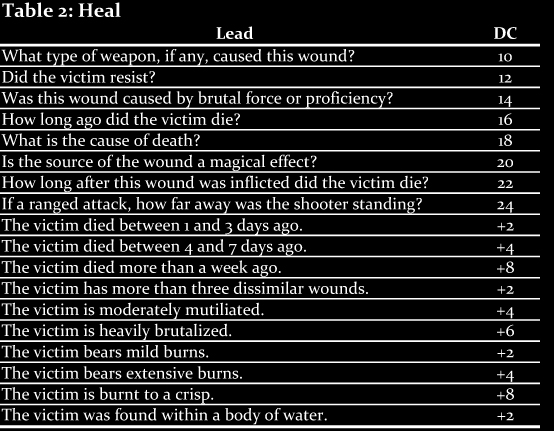
Perception: Chaska has already formed an opinion about what happened here. But she needs something more than just an opinion. Taking a couple steps back, she carefully observes the surroundings, trying to recreate the scene. Moments later, she glimpses another detail. There is a single entry point to the shrine and the female priest was facing towards it. The two men had no time to struggle. Thus, the perpetrator was not initially perceived as a threat. It was a strong person, considering the wounds on the male bodies, most probably a male, and considering the positioning of the bodies, he struck all three with determination, calculating his attack methodically. He was not an angry priest or a disgruntled commoner. This is the work of a professional assassin. Perception works similarly to Appraise and Heal, by permitting you to extract information from the environment. The following table works like the Appraise and Heal tables:
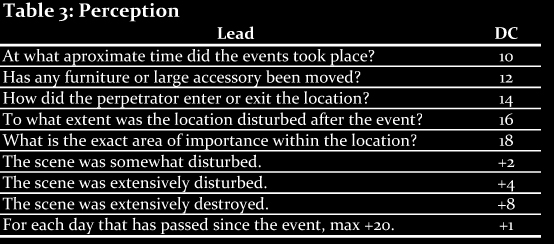
Having collected as much information from the scene as she could, Chaska retires to her home, to continue the research, this time performing an information investigation.
Knowledge: After studying a couple of clerical texts, she concludes that the perpetrator performed the murder of the priestess in a ceremonial manner, while the other two casualties were treated as mere obstacles. Considering the evidence that magic was used, the investigator concludes that the most likely suspect is an athletic male, between 25 and 35, proficient both with the sword and the art of magic, likely a trained assassin. This limits the possible suspects considerably. Besides the typical use of the Knowledge skill, a character can perform a check searching for a pattern in a series of events. The character must investigate each sub-skill individually; for example, a pattern based on arcane lore can only be recognized with a Knowledge (arcana), although the other Knowledge sub-skills can exclude relative possibilities. Such a performance takes at least an hour of study on a properly equipped library. The following table indicates the DC, relative to the complexity of the pattern:
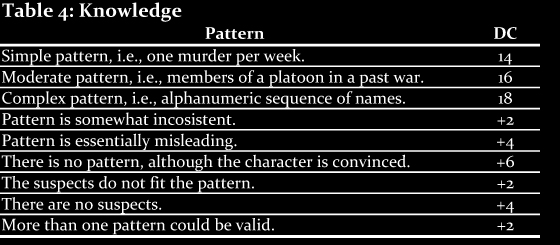
Diplomacy: Having exhausted her existing literary sources, Chaska decides to seek a number of contacts for further information. The night has already taken over the sky dome, but Chaska is not willing to wait. Riding on her horse, she reaches a local blacksmith. Before he even gets a chance to protest about the late hour, she hands ten coins to him, speaking a single word:
“Information.”
“Sigh… Come in…”
“You make blades?”
“You bet I do.”
“Serrated ones?”
“You mean like a saw? Who would want something like that? It’s not good for war.”
“Perhaps. But do you make them?”
“I suppose I could, but I never had such a request.”
*Chaska hands ten more coins to him*
“You are a persistent one, ain’t you? Look, as I said, I don’t make ‘em, but I can tell you who does.”
Diplomacy can be used to gather information as described in the core rules. Given the nature of an investigation, asking many questions to many people costs time, money, and eventually a bolt in the neck. Thus, the following table provides a number of options while using the gather information option of Diplomacy. For each such measure not taken while investigating, there is cumulative 1% chance on each consecutive attempt that an attempt of silencing will occur. For example, if none of the measures below is observed, at the end of the third consecutive attempt there is 15% chance that such an attempt will occur. Consecutive attempts are considered all attempts made in the same community with less than a week of pause between them.

By the middle of the next day, the local authorities managed to acquire testimonies from a number of witnesses. But Chaska is far from satisfied. For her, it is obvious that most of them weren’t even near the event at the time it occurred. Consequently, she moves to question the witnesses herself, including a couple more names in her list, based on her information investigation. As the day slowly fades, Chaska concludes that all witnesses so far have no real information to provide. She takes one more chance, visiting an old lady who supposedly heard the priestess screaming during the event. After introducing herself, Chaska proceeds to ask a number of questions. The old lady’s unwillingness to fully cooperate is a good indication that she is a genuine witness:
“…as I said lass, I was standing here, in this small balcony, when I heard a scream. I saw nobody and didn’t hear anything else thereafter.”
Bluff: Chaska knows that the testimony is probably true, but she takes a chance. Although there were numerous ways for the perpetrator to escape the shrine, she wants to make sure that the streets connecting to this home are not among them.
“As you may have heard, every other way from the shrine, excluding the one just below us, was blocked during that night. So, the murderer certainly passed through here…”
“I told you, I saw nothing! Jabes the baker was the only man I saw on the street, and he could barely hurt a fly! Please, leave me alone; I have nothing else to say.”
Unless someone has a very good reason to help an investigation, most people will simply avoid such a confrontation. Like in the case above, people will make assumptions for the innocence of their fellows, and in any case, investigators come and go, while a false accusation might hang on a community for much longer. A character can try to perform a Bluff check, essentially negating the displayed ignorance of interrogated witnesses and suspects. The basic DC is 15, decreased by -1 for every hypothetical element the character uses to corner the subject, but increased by +2 instead for every such element that the subject acknowledges as false. In the example above, Chaska had a DC of 16. If the old lady knew that the streets were not blocked, the DC would be 17.
Intimidate: Far from having a solid lead, Chaska pursues Jabes the baker for questioning. She finds him resting and particularly unhappy for being awaken, although it is still early evening.
“What is it lass? Can’t you see I am busy?”
“I’ll only ask a few questi…”
“I got no answers. Now leave.”
“I am fine with that, but I should inform you that you have been witnessed near the shrine, at the night of the murder…”
Often, intimidation is based on the physical superiority of an individual towards another. Investigators have another option. Intimidation based on the power of the law. This requires that the case in question is actually backed by legal means, for example by being a case known and investigated by the authorities. Also, the subject in question must have a reasonable preoccupation against the law, although sometimes a Bluff check can achieve that, even if not truthfully. If those conditions apply, the performer can receive a bonus to his Intimidate check, based on the applying conditions. The following table indicates the cumulative bonuses provided relative to the situation at hand:

Sense Motive: Jabes folds in the face of legal persecution, and with a little more encouragement from Chaska, he admits that he was paid a considerable sum to host a stranger, without questions, two days before the incident. That night, he was out, looking for the stranger, since he left without any warning. Chaska stares at him with a mild disregard towards his words, pushing him to tell more.
Besides the obvious usage of this skill in a social investigation, a character can attempt to verify the alibi of a target, comparing all known leads. A successful roll provides intuitive information relative to the status of the target. The DC depends on how much is already known and how accurate is the suspicion, as indicated by the following table:
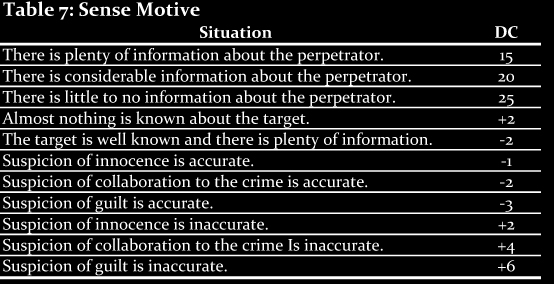
Chaska follows that single lead provided by Jabes, eventually uncovering a far greater case than she initially suspected. Although she manages to lead the perpetrator to the executioner’s blade, the information she gathers sends her hunting much bigger fish than a hired assassin. Leaving aside the story of our exemplary heroine, let’s take a look at a number of feats that extend the repertoire of options of any investigator:
Investigation Feats
Controlled Self-Doubt
“I am sure,” doesn’t mean much to you. You are able to manipulate your instinctual doubt as a tool against uncertainty.
Prerequisites: Int 13, Wis 13, Cha 13.
Benefit: Whenever the DM makes a skill roll for you in secret, you may make a Wisdom check with a DC of 15. If you succeed, the DM will tell you if the roll succeeded or not, but not the exact value of the roll or of the DC. You may use this ability a number of times per day equal to your Intelligence bonus.
Professional Detective
Your familiarity with the procedure of investigation is evident with your capacity to handle every case you undertake.
Prerequisites: Int 13, Wis 13.
Benefit: You receive a +2 bonus to all skills for the purpose of investigating an incident.
Scene Recreation
Through sheer calculative capacity coupled with natural intuition, you are able to reproduce the events that occurred in a location.
Prerequisites: Int 15, Wis 15.
Benefit: Focusing for a minute or so, you are able to visualize the events that occurred at a given location and time, based on the information you have. To do this, you make a Perception check as indicated in the following table. If you succeed, you witness flashes of images during the event. If you fail, you still see related images, but they contain false information:
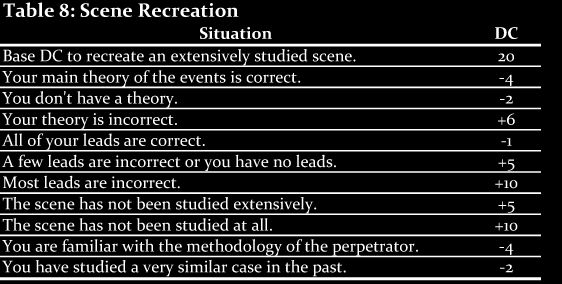
Before you take out your pen and paper to design an investigation-based adventure, take care of a few important points. First of all, magic can easily ruin a carefully crafted plot. Divination spells can render skills useless and many other spells can foil any mundane attempts at persecution. This is not to say that you should not design an investigation-based plot in a typical fantasy setting, but be aware of what kind of spells are in circulation, and how they affect the chances of a classic investigation attempt. Secondly, use logic. Sometimes, things are too evident to require a roll. If your players make the right questions, they can skip making unnecessary rolls, keeping them for times that the group is sitting silently, stuck on a case, threatening the flow of the session with unending idleness. That was all for today, kind traveler. Farewell on your journey and do not forget to come back for more.


